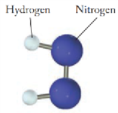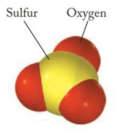
Chemistry Principles And Practice
3rd Edition
ISBN: 9781305295803
Author: David Reger; Scott Ball; Daniel Goode
Publisher: Cengage Learning
expand_more
expand_more
format_list_bulleted
Question
Chapter 2, Problem 2.69QE
(a)
Interpretation Introduction
Interpretation:
Molecular formula for the given diagram has to be written.

Concept Introduction:
Molecular formula is a simple representation of a compound using the atomic symbols of the constituent elements present in it. In molecular formula, the subscript after the atomic symbol represent the number of atoms of the same element is present in the compound.
(b)
Interpretation Introduction
Interpretation:
Molecular formula for the given diagram has to be written.

Concept Introduction:
Refer part (a).
Expert Solution & Answer
Want to see the full answer?
Check out a sample textbook solution
Students have asked these similar questions
For the titration of a divalent metal ion (M2+) with EDTA, the stoichiometry of the reaction is typically:
1:1 (one mole of EDTA per mole of metal ion)
2:1 (two moles of EDTA per mole of metal ion)
1:2 (one mole of EDTA per two moles of metal ion)
None of the above
Please help me solve this reaction.
Indicate the products obtained by mixing 2,2-dimethylpropanal with acetaldehyde and sodium ethoxide in ethanol.
Chapter 2 Solutions
Chemistry Principles And Practice
Ch. 2 - Prob. 2.1QECh. 2 - State how Daltons atomic theory explains (a) the...Ch. 2 - Prob. 2.3QECh. 2 - Prob. 2.4QECh. 2 - Prob. 2.5QECh. 2 - Prob. 2.6QECh. 2 - Prob. 2.7QECh. 2 - Describe the arrangement of protons, neutrons, and...Ch. 2 - Prob. 2.9QECh. 2 - Prob. 2.10QE
Ch. 2 - A mass spectrometer determines isotopic masses to...Ch. 2 - Prob. 2.12QECh. 2 - Prob. 2.13QECh. 2 - Prob. 2.14QECh. 2 - Prob. 2.15QECh. 2 - Prob. 2.16QECh. 2 - Sulfur dioxide, SO2, is a molecular compound that...Ch. 2 - Prob. 2.18QECh. 2 - Prob. 2.19QECh. 2 - Prob. 2.20QECh. 2 - Prob. 2.21QECh. 2 - Prob. 2.22QECh. 2 - Prob. 2.23QECh. 2 - Prob. 2.24QECh. 2 - Prob. 2.25QECh. 2 - Prob. 2.26QECh. 2 - Prob. 2.27QECh. 2 - Prob. 2.28QECh. 2 - Prob. 2.29QECh. 2 - Give the complete symbol (XZA), including atomic...Ch. 2 - Prob. 2.31QECh. 2 - Prob. 2.32QECh. 2 - Prob. 2.33QECh. 2 - Prob. 2.34QECh. 2 - Prob. 2.35QECh. 2 - Prob. 2.36QECh. 2 - Prob. 2.37QECh. 2 - Prob. 2.38QECh. 2 - Prob. 2.39QECh. 2 - Prob. 2.40QECh. 2 - Prob. 2.41QECh. 2 - Prob. 2.42QECh. 2 - Prob. 2.43QECh. 2 - Prob. 2.44QECh. 2 - Prob. 2.45QECh. 2 - Prob. 2.46QECh. 2 - Prob. 2.47QECh. 2 - Prob. 2.48QECh. 2 - Prob. 2.49QECh. 2 - Prob. 2.50QECh. 2 - Prob. 2.51QECh. 2 - Prob. 2.52QECh. 2 - Prob. 2.53QECh. 2 - Prob. 2.54QECh. 2 - Prob. 2.55QECh. 2 - Prob. 2.56QECh. 2 - Prob. 2.57QECh. 2 - Prob. 2.58QECh. 2 - Prob. 2.59QECh. 2 - Prob. 2.60QECh. 2 - Prob. 2.61QECh. 2 - Prob. 2.62QECh. 2 - Prob. 2.63QECh. 2 - Prob. 2.64QECh. 2 - Prob. 2.65QECh. 2 - Prob. 2.66QECh. 2 - Prob. 2.67QECh. 2 - Prob. 2.68QECh. 2 - Prob. 2.69QECh. 2 - Prob. 2.70QECh. 2 - Prob. 2.71QECh. 2 - Prob. 2.72QECh. 2 - Prob. 2.73QECh. 2 - Prob. 2.74QECh. 2 - Prob. 2.75QECh. 2 - Prob. 2.76QECh. 2 - Prob. 2.77QECh. 2 - Prob. 2.78QECh. 2 - Prob. 2.79QECh. 2 - Prob. 2.80QECh. 2 - Prob. 2.81QECh. 2 - Prob. 2.82QECh. 2 - Prob. 2.83QECh. 2 - Prob. 2.84QECh. 2 - Prob. 2.85QECh. 2 - Prob. 2.86QECh. 2 - Prob. 2.87QECh. 2 - Prob. 2.88QECh. 2 - Prob. 2.89QECh. 2 - Prob. 2.90QECh. 2 - Prob. 2.91QECh. 2 - Prob. 2.92QECh. 2 - Prob. 2.93QECh. 2 - Prob. 2.94QECh. 2 - Prob. 2.95QECh. 2 - Prob. 2.96QECh. 2 - Write the formula of (a) manganese(III) sulfide....Ch. 2 - Prob. 2.98QECh. 2 - Prob. 2.99QECh. 2 - Prob. 2.100QECh. 2 - Prob. 2.101QECh. 2 - Prob. 2.102QECh. 2 - Prob. 2.103QECh. 2 - Prob. 2.104QECh. 2 - Prob. 2.105QECh. 2 - Prob. 2.106QECh. 2 - Prob. 2.107QECh. 2 - Prob. 2.108QECh. 2 - Prob. 2.109QECh. 2 - Prob. 2.110QECh. 2 - Prob. 2.111QECh. 2 - Prob. 2.112QECh. 2 - Prob. 2.113QECh. 2 - Prob. 2.114QECh. 2 - Prob. 2.115QECh. 2 - Prob. 2.116QECh. 2 - Prob. 2.117QECh. 2 - Prob. 2.118QECh. 2 - Prob. 2.119QECh. 2 - Prob. 2.120QECh. 2 - Prob. 2.121QECh. 2 - Prob. 2.122QECh. 2 - Prob. 2.123QECh. 2 - Prob. 2.124QECh. 2 - Prob. 2.125QECh. 2 - Prob. 2.126QECh. 2 - Prob. 2.127QECh. 2 - Prob. 2.128QECh. 2 - Prob. 2.129QECh. 2 - Prob. 2.130QECh. 2 - Prob. 2.131QECh. 2 - Prob. 2.132QECh. 2 - Prob. 2.133QECh. 2 - Prob. 2.134QECh. 2 - Prob. 2.135QECh. 2 - Prob. 2.136QE
Knowledge Booster
Learn more about
Need a deep-dive on the concept behind this application? Look no further. Learn more about this topic, chemistry and related others by exploring similar questions and additional content below.Similar questions
- Synthesize 2-Ethyl-3-methyloxirane from dimethyl(propyl)sulfonium iodide using the necessary organic or inorganic reagents. Draw the structures of the compounds.arrow_forwardSynthesize 2-Hydroxy-2-phenylacetonitrile from phenylmethanol using the necessary organic or inorganic reagents. Draw the structures of the compounds.arrow_forwardSynthesize N-Methylcyclohexylamine from cyclohexanol using the necessary organic or inorganic reagents. Draw the structures of the compounds.arrow_forward
- Synthesize N-Methylcyclohexylamine from cyclohexanol using the necessary organic or inorganic reagents. Draw the structures of the compounds.arrow_forwardIf possible, please provide the formula of the compound 3,3-dimethylbut-2-enal.arrow_forwardSynthesize 1,4-dibromobenzene from acetanilide (N-phenylacetamide) using the necessary organic or inorganic reagents. Draw the structures of the compounds.arrow_forward
- Indicate the products obtained by mixing (3-oxo-3-phenylpropyl)triphenylphosphonium bromide with sodium hydride.arrow_forwardWe mix N-ethyl-2-hexanamine with excess methyl iodide and followed by heating with aqueous Ag2O. Indicate the major products obtained.arrow_forwardIndicate the products obtained by mixing acetophenone with iodine and NaOH.arrow_forward
- Indicate the products obtained by mixing 2-Propanone and ethyllithium and performing a subsequent acid hydrolysis.arrow_forwardIndicate the products obtained if (E)-2-butenal and 3-oxo-butanenitrile are mixed with sodium ethoxide in ethanol.arrow_forwardQuestion 3 (4 points), Draw a full arrow-pushing mechanism for the following reaction Please draw all structures clearly. Note that this intramolecular cyclization is analogous to the mechanism for halohydrin formation. COH Br + HBr Brarrow_forward
arrow_back_ios
SEE MORE QUESTIONS
arrow_forward_ios
Recommended textbooks for you
 Chemistry: Principles and PracticeChemistryISBN:9780534420123Author:Daniel L. Reger, Scott R. Goode, David W. Ball, Edward MercerPublisher:Cengage Learning
Chemistry: Principles and PracticeChemistryISBN:9780534420123Author:Daniel L. Reger, Scott R. Goode, David W. Ball, Edward MercerPublisher:Cengage Learning Chemistry: The Molecular ScienceChemistryISBN:9781285199047Author:John W. Moore, Conrad L. StanitskiPublisher:Cengage Learning
Chemistry: The Molecular ScienceChemistryISBN:9781285199047Author:John W. Moore, Conrad L. StanitskiPublisher:Cengage Learning General Chemistry - Standalone book (MindTap Cour...ChemistryISBN:9781305580343Author:Steven D. Gammon, Ebbing, Darrell Ebbing, Steven D., Darrell; Gammon, Darrell Ebbing; Steven D. Gammon, Darrell D.; Gammon, Ebbing; Steven D. Gammon; DarrellPublisher:Cengage Learning
General Chemistry - Standalone book (MindTap Cour...ChemistryISBN:9781305580343Author:Steven D. Gammon, Ebbing, Darrell Ebbing, Steven D., Darrell; Gammon, Darrell Ebbing; Steven D. Gammon, Darrell D.; Gammon, Ebbing; Steven D. Gammon; DarrellPublisher:Cengage Learning Chemistry: Principles and ReactionsChemistryISBN:9781305079373Author:William L. Masterton, Cecile N. HurleyPublisher:Cengage Learning
Chemistry: Principles and ReactionsChemistryISBN:9781305079373Author:William L. Masterton, Cecile N. HurleyPublisher:Cengage Learning Introductory Chemistry: A FoundationChemistryISBN:9781337399425Author:Steven S. Zumdahl, Donald J. DeCostePublisher:Cengage Learning
Introductory Chemistry: A FoundationChemistryISBN:9781337399425Author:Steven S. Zumdahl, Donald J. DeCostePublisher:Cengage Learning Chemistry & Chemical ReactivityChemistryISBN:9781337399074Author:John C. Kotz, Paul M. Treichel, John Townsend, David TreichelPublisher:Cengage Learning
Chemistry & Chemical ReactivityChemistryISBN:9781337399074Author:John C. Kotz, Paul M. Treichel, John Townsend, David TreichelPublisher:Cengage Learning

Chemistry: Principles and Practice
Chemistry
ISBN:9780534420123
Author:Daniel L. Reger, Scott R. Goode, David W. Ball, Edward Mercer
Publisher:Cengage Learning

Chemistry: The Molecular Science
Chemistry
ISBN:9781285199047
Author:John W. Moore, Conrad L. Stanitski
Publisher:Cengage Learning

General Chemistry - Standalone book (MindTap Cour...
Chemistry
ISBN:9781305580343
Author:Steven D. Gammon, Ebbing, Darrell Ebbing, Steven D., Darrell; Gammon, Darrell Ebbing; Steven D. Gammon, Darrell D.; Gammon, Ebbing; Steven D. Gammon; Darrell
Publisher:Cengage Learning

Chemistry: Principles and Reactions
Chemistry
ISBN:9781305079373
Author:William L. Masterton, Cecile N. Hurley
Publisher:Cengage Learning

Introductory Chemistry: A Foundation
Chemistry
ISBN:9781337399425
Author:Steven S. Zumdahl, Donald J. DeCoste
Publisher:Cengage Learning

Chemistry & Chemical Reactivity
Chemistry
ISBN:9781337399074
Author:John C. Kotz, Paul M. Treichel, John Townsend, David Treichel
Publisher:Cengage Learning
GCSE Chemistry - Differences Between Compounds, Molecules & Mixtures #3; Author: Cognito;https://www.youtube.com/watch?v=jBDr0mHyc5M;License: Standard YouTube License, CC-BY